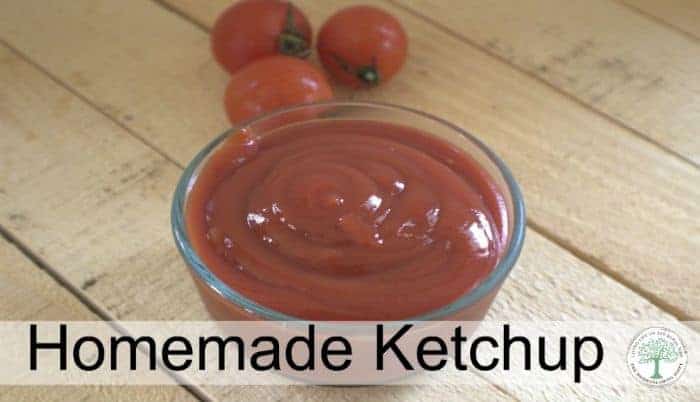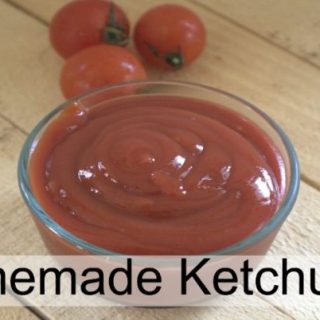Ketchup is almost a food group in our home. My kids and husband could practically drink it and they put it on everything. There are weeks when we can go through 2-3 pints of homemade ketchup.
Seriously. We can’t stop drinking it.

Why lacto fermented ketchup? The benefits of fermented foods are amazing. They include:
- probiotic rich
- digestive supporting enzymes
- they help us to absorb other nutrients
- can help heal leaky gut
- they are relatively inexpensive to make at home
How Do Fermented Foods Work?
Food fermentation is one of the most ancient methods of preserving food. When you do this, you will be able to produce a variety of foods including wine, cheese, yogurt, sauerkraut, and kombucha.
While the reality is that most of these are quite difficult to produce at home, homemade lactofermented ketchup is one of those fermented foods that is surprisingly easy to make.
And there are plenty of reasons to do so!
Fermentation is a process by which microorganisms (including bacteria and yeast) work together to convert carbohydrates into acids or alcohol.
These then act like a natural preservative, giving your fermented foods their trademark zestiness. It also helps encourage the growth of beneficial bacteria.
Adding fermented foods to your diet not only improves your digestive functioning but can also boost your immune system, too.
Why You Should Make Lacto Fermented Ketchup
If you’re reading this and you live in the United States, you probably know what a huge kitchen staple ketchup is. It’s kind of sweet, kind of salty, and it’s absolutely delicious.
You can put it on everything from a hot dog to a French fry, and it’s so versatile that it’s found in practically everybody’s refrigerator.
Unfortunately, store-bought ketchup isn’t all that great for you. It’s loaded with nasty ingredients like high fructose corn syrup.
Not only do these add unnecessary calories, but they can leave you feeling logey, too.
Lacto fermented ketchup is a great way to benefit from all the fantastic features of fermented foods.
Not only that, but it’s a good way to use up all of those extra tomatoes from your garden harvest. It can be frozen or canned, too, making it a good option for long-term storage.
If you’re new to fermenting your own foods, lacto fermented ketchup is a great way to start. You probably won’t even notice the difference!
A Few Recipe Notes
You may notice that this recipe calls for premade tomato paste. You can make some from scratch for this recipe, or you can use the store-bought kind. It’s up to you.
If you have a ton of tomatoes on hand, making your own is a good option. If you do this, you will want to use San Marzano or a similar type of paste tomato.
You can also substitute out the whey if you don’t have any. Man people use a pickle brine with things like apple cider vinegar or white vinegar. Also perfectly acceptable! If you do this, it will result in a thinner ketchup.
Some people recommend completely leaving the whey out of the recipe. If you do this, the ketchup will still taste pretty much the same – but you won’t be getting all the probiotic benefits.
Now, if you want to make a homemade ketchup following this same recipe, you definitely can. Just skip the whey and put the ketchup in the fridge as soon as you can.
It, of course, won’t last quite as long, but as long as you eat it up quickly (which you shouldn’t have problems doing!) you will be fine.
In fact, I recommend making more than one jar at a time, since you will love it so very much!
Another note is that you may find the ketchup too thick for your tastes after combining the ingredients. It will become even thicker when the fermentation process is all said and done.
Therefore, you might need to add a couple of tablespoons of water. Another ingredient you can add that will not only give the ketchup a umami element but also improve its texture is Worcestshire sauce – maple syrup would be another option.
Keep in mind that you can add other ingredients, too, to suit your tastes. I wouldn’t add anything that might alter the composition of the ketchup, but spices and herbs like garlic, cinnamon, cayenne, mustard powder, and clove are certainly acceptable.
What are you waiting for? Let’s get started making our own lacto-fermented ketchup! It’s so easy, you’ll wonder why you waited so long.

Homemade Lacto Fermented Ketchup Recipe
Ingredients
- 1 1/2 cups tomato paste
- 1/2 cup more or less filtered water
- 1/4 cup whey
- 1 tablespoon honey
- 2 cloves garlic
- 1 1/2 teaspoons sea salt
- 1/8 teaspoon ground cayenne or to taste
- 1/2 teaspoon ground cloves
- 1/2 teaspoon ground allspice
- 1/2 teaspoon black pepper
Instructions
- Blend all the spices together in a medium sized bowl.
- Add to the rest of the ingredients in a non-reactive bowl and stir well to combine.
- Add filtered water to achieve the consistency that you prefer. It will thicken as it stands, so you might want to leave this a little on the thin side.
- Transfer ketchup to a jar with a tight-fitting lid and allow to sit at room temperature for 72 hours before transferring to refrigerator for long-term storage.
Using Lacto Fermented Ketchup
To use, simply use as you would regular ketchup. Top a grass fed burger, smear over homemade french fries, top your meatloaf. The possibilities are endless. The shelf life of this ketchup is approximately 3 weeks. I can’t be more sure, to be honest, because it’s never around that long.
Have you ever made your own lacto fermented ketchup? What foods do you make fermented at home?

Heather’s homesteading journey started in 2006, with baby steps: first, she got a few raised beds, some chickens, and rabbits. Over the years, she amassed a wealth of homesteading knowledge, knowledge that you can find in the articles of this blog.
Learn more about Heather and the rest of the writers on this page.

This is a neat way to make homemade ketchup. Thanks for sharing!
thanks! Hope you like it!
I’ve always been curious about making my own condiments. I’d like to try mayonnaise, but it requires raw eggs and I need to really trust the eggs! Does this ketchup has a sour taste to it?
it’s a “bit” on the “sour” side, but for me, anyway, it’s not enough to really notice too much. It’s not as sweet as commercial ketchup
That looks like a nice, simple recipe. I should turn my husband loose on it. 🙂 He made some amazing barbeque sauce for a recipe last week (just on the fly) because it turned out that we were out of the jarred stuff.
Wow You Always Makes Things Look So Easy I Must Try This Thank You!
That looks good. I never thought to make my own ketchup.
Heather, is there anyway to improve the recipe so it doesn’t come out a little sour as you indicated? Thanks!!!
I would think that perhaps not as much salt, or adding in a bit more sugar may help?
I have never tried making my own ketchup. I am not sure why, I love to can and make things from scratch. I will have to give this a try!
Do I cover the bowl with anything?
I cover mine with a lid that fits well.
I can’t use whey, is there a non milk derived alternative?
You can always open a capsule of a good probiotic and sprinkle that in. I have done that before when fermenting foods.
Would using a very active brine from another ferment work? Like maybe some from some garlic or a onion ferment?
This sounds great! Will I be able to add horseradish to this ketchup to make cocktail sauce?
sure!
Where do you get whey? And what bowls are non reactive?